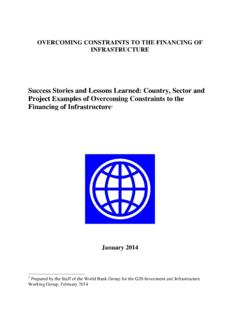Transcription of W57563 Guide to Illiquid Credit - mandg.co.uk
1 A Guide to Illiquid creditNew opportunities for institutional investorsOctober 20143 William NicollCo-Head of Alternative Credit , Fixed IncomeWelcomeAs investment banks have retreated from the provision of finance to large swathes of the economy so the opportunity for long-term institutional investors has grown. They are taking this opportunity by investing in Illiquid much has been written about the concept of illiquidity, a lot less has been written about the types of instrument that make up this asset class. This is understandable given that so many of the frequently complex loans that constitute the Illiquid Credit market have been locked away in bank vaults for so long. Illiquid assets has become a shorthand for bespoke, private assets that are not generally available to investors. The illiquidity premium has become shorthand for the various premia that should attach to an asset that is bespoke, non-standard and Guide aims to unearth more detail about these assets, explain the benefits they can bring to investors who do not need liquidity across their entire portfolio and set out some of the pros and cons of Illiquid Credit Investments has been investing in private and Illiquid debt since 1997.
2 In 2014 it was ranked as Europe s first and the world s fifth largest manager of private debt by Private Debt investor value of investments will fluctuate, which will cause prices to fall as well as rise and investors may not get back the original amount they , introduced .. 6 The origins of Illiquid Credit : 4,000 years of funding business .. 8 Banks secession from some Credit markets: a new market norm emerges .. 9 Illiquid Credit s appeal to institutional investors .. 11 How to approach Illiquid Credit ..14A word of caution ..16 Case studies .. 17 Glossary of terms ..19 Contents6 Illiquid Credit is an area of growing interest for institutional investors in Europe. It is most simply defined as assets that do not have an active secondary market in which they can be traded. However, this rather sweeping definition covers a wide range of debt securities with very different characteristics and purposes.
3 Illiquid Credit assets can be long-term, such as 25-year leases on commercial property, or shorter-dated, such as directly arranged corporate loans or supply chain finance. Banks used to be the pre-eminent lenders of this type of debt to the majority of European borrowers. As the investment banks have retreated over the past six years the capital markets have changed significantly. Previously, it was in the interest of the banking sector to expend huge efforts to package up debt for the public markets and institutional investors in a relatively simple format. The availability of cheap capital and the homogeneity of the packages that they produced meant that they were able to offer investors liquidity. Today, pressured by regulatory and commercial considerations, banks are finding many such loans either too expensive or too unattractive to renew, and are pulling back from vast chunks of the market.
4 Furthermore, there is no incentive for them to package assets for investors and it is significantly more expensive for them to offer the same time, governments are taking steps to encourage a broader range of finance providers to extend these institutional investors, we believe this means that Illiquid Credit is emerging as an attractive set of investment opportunities. It takes the familiar principles of debt or bond investing the lending of money in return for regular interest payments into less standardised areas such as private debt. Many companies and projects are now coming directly to investors for financing and the burden of packaging and structuring assets is falling on the investor . It does mean that these assets will not be liquid because there is no reason for the banks to offer liquidity if they are not making fees from packaging and in these assets could provide an institutional investor with an income stream in excess of that from corporate bonds, from credits not available in public bond excess return is derived from the inherent complexity and illiquidity of the assets.
5 In simple terms, investors want to be paid more to hold things that can be difficult to understand and hard to assets also provide opportunities to generate specific kinds of regular cashflows for investors. Many offer floating rate or inflation-linked coupons, which can protect investors from rises in interest rates or from , introduced7 There are broadly three types of Illiquid Credit : long-dated, often inflation-linked assets; five- to seven-year maturity investments; and unique, specialist opportunities that can offer impressive risk-adjusted of cashflowsLong-termSocial housing debtPrivately arranged, secured bonds to Housing Association Regulated Providers. No secured lender to these entities has suffered a Credit rate/ inflation-linkedLong-lease propertyProperty acquired and leased back to tenant on a long-term basis. Rental payments benefit from fixed or inflation-linked uplifts.
6 Often development inflation-linkedInfrastructure debtDebt provided to a variety of infrastructure sub-sectors including renewable energy and economic infrastructure. Finances new projects and refinances existing rate/ inflation-linkedGround rentsLong-term, inflation-linked senior payments payable to freeholder of property secured on residential or commercial rate/ inflation-linkedIncome stripsLong-term lease arrangements secured on property; rental payments are inflation-linked. Property returned to tenant at end of lease. Often development inflation-linkedShort to medium-termDirect lending to UK companiesFloating-rate loans provided directly to mid-sized UK businesses. Floating ratePrivate placementsLending to European mid-sized to larger companies. Private note structure; historically bought by insurance companies. A European private placement market is emerging which is expected to provide an increasing number of investment fixed rateLeasingFinancing for companies which provide leasing of hard assets such as heavy machinery ( forklift trucks).
7 Fixed rateTrade receivablesShort-term supply chain financing for smaller companies buying the right to receive payments due to the rate (short-term)Senior/Junior commercial European mortgagesLoans secured against commercial property at high (senior) or lower (junior) levels in the capital floating rateHigher-yielding mixed termDebt opportunitiesInvestment in Credit of fundamentally sound companies that are undergoing debt or floating rateRegulatory capital tradesPurchase of junior portions of banks corporate loan books; banks gain regulatory capital relief from the rateInsurance riskOut of the money insurance risk ( longevity). Regulatory capital trades for insurance rate8 The origins of Illiquid Credit : 4,000 years of funding businessCompanies have long used Credit to help them to supply goods and services to the economy. The practices of paying a fee to borrow land or equipment, or exchanging unpaid invoices for upfront cash, have existed for thousands of , for instance, is believed to have begun in ancient Sumer in Mesopotamia (modern-day Iraq) at around 2000 BC, where records show people renting land, cattle and farming tools.
8 At about the same time, merchants were starting to buy up outstanding promises of payment from agents for cash. This type of supply chain finance, known as factoring, was well-established in Britain by medieval times and helped to develop the cloth and corn trades. Today, Credit is an integral part of companies activity. An estimated 80% of UK business-to-business transactions take place on Credit (ACCA, June 2014), while two thirds (66%) of the UK s commercial property, worth a combined 376bn, is leased rather than owned (as of 2012, British Property Federation). For decades, finance of this nature has been provided primarily by banks, which have forged close relationships with companies and arranged Credit through one-to-one contracts. This brings us to the starting point for any understanding of Illiquid Credit investing: these debt instruments do not have a functioning secondary market, so are usually held until maturity.
9 The lack of a secondary market is important for two reasons. First, many of the corporate loans, leasing agreements and property-related debt now collectively known as Illiquid Credit are bespoke, created for the benefit of lender and borrower alone, and there has traditionally been little need, nor indeed much opportunity, to materially alter an arrangement during the life of a loan. When the agreement came to an end the borrower might refinance it, but there was never any intention of it being traded. Secondly, this means there has been no way for other parties, such as institutional investors, to gain access to these loans. With such lending squirrelled away by the sell-side, how would a buy-side institution have any access to it? Until recently there was never any window on them. Of course fund managers, pension funds and insurance companies played an indirect role by providing the funding to banks that ultimately financed such lending.
10 For many years banks would raise capital cheaply through the sale of corporate bonds and other debt securities in capital would then lend to their clients at a higher interest rate, pocketing the difference. This provision of finance to longer-term borrowers, set against short-term liabilities, proved a long-standing and lucrative business model. But all this changed in 2008, and from that time institutional investors have started to prise the system apart. 9 Banks secession from some Credit markets: a new market norm emergesIn 2008, the banks funding model inverted, as inversion was triggered by the simple fact that many bond investors recognised that bank balance sheets are not as straightforward as they previously looked. As the crisis unfolded, investors grew increasingly concerned that banks were exposed to risky, non-traditional assets but could pledge safe, traditional assets, such as residential mortgages, to access cheap funding, removing them from the pool of assets available to repay corporate bonds should a bank default.









